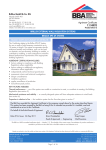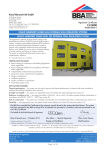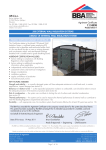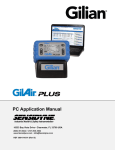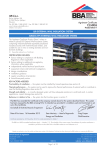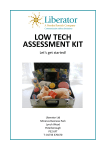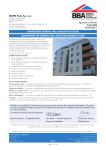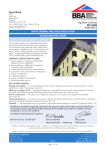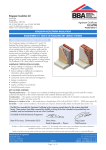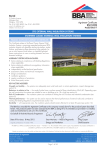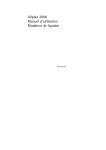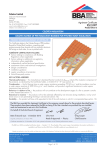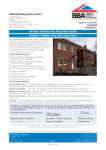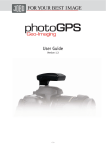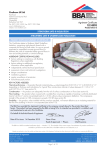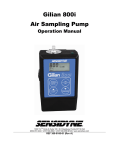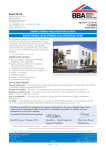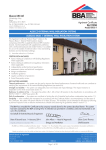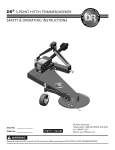Download Brillux GmbH & Co. KG BRILLUX EXTERNAL WALL INSULATION
Transcript
Brillux GmbH & Co. KG APPROVAL INSPECTION TESTING CERTIFICATION Weseler Straße 401 48163 Münster Germany Tel: 00 49 (0) 25 17 18 81 58 Fax: 00 49 (0) 25 17 18 85 82 20 TECHNICAL APPROVALS FOR CONSTRUCTION Agrément Certificate 11/4832 e-mail: [email protected] website: www.brillux.de or www.brillux.com Product Sheet 3 BRILLUX EXTERNAL WALL INSULATION SYSTEMS BRILLUX ETICS MW POWDER SYSTEM PRODUCT SCOPE AND SUMMARY OF CERTIFICATE This Certificate relates to the Brillux ETICS MW Powder System, for use on walls of solid masonry construction up to 18 metres in height. The system incorporates specific reinforced renders and insulation, and can be used on domestic and non-domestic buildings to enable, or contribute to enabling, a wall construction to meet the thermal performance requirements of the appropriate building regulations. AGRÉMENT CERTIFICATION INCLUDES: • factors relating to compliance with Building Regulations where applicable • factors relating to additional non-regulatory information where applicable • independently verified technical specification • assessment criteria and technical investigations • design considerations • installation guidance • regular surveillance of production • formal three-yearly review. KEY FACTORS ASSESSED Thermal performance — use of the system can enable a construction to meet, or contribute to meeting, the Building Regulations (see section 5). Mechanical resistance and stability — a correctly designed system will have adequate resistance to wind loads (see section 6). Properties in relation to fire — the insulation system has the Euroclass given in section 7. The BBA has awarded this Agrément Certificate to the company named above for the system described herein. This system has been assessed by the BBA as being fit for its intended use provided it is installed, used and maintained as set out in this Certificate. On behalf of the British Board of Agrément Date of First issue: 24 May 2011 Brian Chamberlain Greg Cooper Head of Approvals — Engineering Chief Executive The BBA is a UKAS accredited certification body — Number 113. The schedule of the current scope of accreditation for product certification is available in pdf format via the UKAS link on the BBA website at www.bbacerts.co.uk Readers are advised to check the validity and latest issue number of this Agrément Certificate by either referring to the BBA website or contacting the BBA direct. British Board of Agrément Bucknalls Lane Garston, Watford Herts WD25 9BA ©2011 Page 1 of 16 tel: 01923 665300 fax: 01923 665301 e-mail: [email protected] website: www.bbacerts.co.uk Regulations In the opinion of the BBA, the Brillux ETICS MW Powder System, if used in accordance with the provisions of this Certificate, will meet or contribute to meeting the relevant requirements of the following Building Regulations: The Building Regulations 2010 (England and Wales) Requirement: A1 Loading Comment: The system can sustain and transmit wind loads to the substrate wall. See sections 6.4 and 6.8 of this Certificate. Requirement: B4(1) External fire spread Comment: The system is designated Class 0 and can, therefore, meet this Requirement. See sections 7.1 to 7.3 and 7.5 of this Certificate. Requirement: C2(b)(c) Resistance to moisture Comment: Requirement: L1(a)(i) Conservation of fuel and power Walls incorporating the system can meet this Requirement. See section 9.3 of this Certificate. Comment: The system can enable, or contribute to enabling, a construction to meet the Target Emission Rate. See sections 5.1 and 5.3 of this Certificate. Requirement: Regulation 7 Materials and workmanship Comment: The system is acceptable. See section 12.1 and the Installation part of this Certificate. The Building (Scotland) Regulations 2004 (as amended) Regulation: 8(1)(2) Regulation: Standard: 9 1.1 2.6 2.7 3.10 3.15 Condensation Walls insulated with the system can satisfy the requirements of this Standard, with reference to clauses 3.15.1(1), 3.15.4(1) and 3.15.5(1). See sections 10.6 and 10.7 of this Certificate. Comment: Standards: Precipitation Walls insulated with the system can satisfy this Standard, with reference to clauses 3.10.1(1)(2) and 3.10.6(1)(2). See section 9.3 of this Certificate. Comment: Standard: Spread on external walls The system incorporates materials which would not be classed as ‘non-combustible’ as defined in this Standard under clauses 2.7.1(1)(2) and 2.7.2(2) and should not, therefore, be used on walls one metre or less from a boundary. See sections 7.1 to 7.3 and 7.5 of this Certificate. Comment: Standard: Spread to neighbouring buildings The system has a ‘low risk’ surface classification but incorporates materials which would not be classed as ‘non-combustible’. Completed walls, therefore, would be regarded as unprotected areas as defined in this Standard, with reference to clauses 2.6.1(1)(2), 2.6.2(1)(2), 2.6.4(1)(2), 2.6.5(1) and 2.6.6(2). See sections 7.1 to 7.3 and 7.5 of this Certificate. Comment: Standard: Building standards — construction Structure The system can sustain and transmit wind loads to the substrate wall. See sections 6.4 and 6.8 of this Certificate. Comment: Standard: Fitness and durability of materials and workmanship The use of the system satisfies the requirements of this Regulation. See sections 11.1 and 12.1 and the Installation part of this Certificate. Comment: 6.1(b) 6.2 Carbon dioxide emissions Building insulation envelope The system can contribute to satisfying these Standards, with reference to all or parts of clauses 6.1.1(1), 6.1.2(1)(2), 6.1.3(2), 6.1.5(2), 6.1.6(1), 6.2.1(1), 6.2.3(1), 6.2.4(1), 6.2.5(1)(2) and 6.2.10(2). See sections 5.1 and 5.3 of this Certificate. Comment: (1) Technical Handbook (Domestic). (2) Technical Handbook (Non-Domestic). The Building Regulations (Northern Ireland) 2000 (as amended) Regulation: B2 Fitness of materials and workmanship Comment: Regulation: B3(2) Suitability of certain materials Comment: Regulation: C4(b) Resistance to ground moisture and weather Comment: Regulation: C5 Condensation The system is acceptable. See section 12.1 and the Installation part of this Certificate. The system is acceptable. See section 11.1 of this Certificate. Walls insulated with the system can satisfy this Regulation. See section 9.3 of this Certificate. Walls insulated with the system can satisfy the requirements of this Regulation. See sections 10.6 and 10.7 of this Certificate. Comment: Regulation: Comment: D1 Stability The system can sustain and transmit wind loads to the substrate wall. See sections 6.4 and 6.8. of this Certificate. Page 2 of 16 Regulation: E5(a) Regulations: External fire spread The system has a Class 0 classification surface and can satisfy this Regulation. See sections 7.1 to 7.3 and 7.5 of this Certificate. Comment: F2(a)(i) F3(2) Comment: Conservation measures Target carbon dioxide Emissions Rate The system can enable a construction to meet the requirements of these Regulations. See sections 5.1 and 5.3 of this Certificate. Construction (Design and Management) Regulations 2007 Construction (Design and Management) Regulations (Northern Ireland) 2007 Information in this Certificate may assist the client, CDM co-ordinator, designer and contractors to address their obligations under these Regulations. See section: 2 Delivery and site handling (2.1) of this Certificate. Non-regulatory Information NHBC Standards 2011 NHBC accepts the use of the Brillux ETICS MW Powder System for masonry walls, when installed and used in accordance with this Certificate, in relation to NHBC Standards, Part 6 Superstructure (excluding roofs), Chapter 6.9 Curtain Walling and cladding. General This Certificate is a Confirmation of Irish Agrément Board Certificate 10/0344 issued by the National Standards Authority of Ireland (NSAI) to Brillux GmbH & Co. KG, Weseler Straße 401, 48163 Münster, Germany. Technical Specification 1 Description 1.1 The Brillux ETICS MW Powder System is for use on external walls of masonry construction. It is mechanically fixed and bonded to the substrate. The adhesive used with the system is supplementary. 1.2 The effect of the installation of the system on the acoustic performance of a construction is outside the scope of this Certificate. 1.3 The components of the basic wall system (see Figure 1) from outer to inner comprise: Finishes • Brillux Light Mineral Plaster KR or R (particle sizes 2, 3, 4 and 5 mm) and Brillux Light Mineral Plaster G, thin-layered cement-based powders requiring the addition of approximately 30% (KR and R) and 48% (G) of water, for use with Brillux Plaster Primer 3710, if applicable • Brillux Silicate-Plaster KR or R (particle sizes 2 and 3 mm), ready to use combined paste and acrylic/silicate binder, for use with Brillux Silicate Brush-on Filler 3639 • Brillux Rausan KR or R (particle sizes 1, 2, 3, 4 and 5 mm), ready to use combined paste and vinylic binder, for use with Brillux Plaster Primer 3710 • Brillux Silicone-Plaster KR or R and Brillux Silcosil KR or R (particle sizes 2 and 3 mm), ready to use combined paste and vinylic/siloxane binder, for use with Brillux Plaster Primer 3644, if applicable Primers • Brillux Plaster Primer 3710, ready to use, pigmented, liquid vinylic binder • Brillux Silicone-Plaster Primer 3644, ready to use, pigmented, liquid vinylic/siloxane binder • Brillux Silikat Brush-on Filler 3639, ready to use, pigmented, liquid acrylic/silicate binder Basecoat • Brillux ETICS Powder Adhesive 3550 or VZ 3600, cement-based powders requiring the addition of water Reinforcing meshes • Brillux ETICS Glass Fibre Mesh 3797, alkali- and slide-resistant glass fibre mesh with a mass per unit area of approximately 160 g·m–2 and a mesh size of approximately 5 mm x 4.5 mm • Brillux ETICS Armouring Mesh 3773, alkali- and slide-resistant glass fibre reinforced mesh with a mass per unit area of approximately 530 g·m–2, to be used in addition to the above mesh to improve impact resistance Page 3 of 16 Fixings • Ejotherm ST U, STR U and NT U • TERMOZ 8 U, 8 UZ, 8 N and KS 8 • Hilti XI-FV, SX-FV, SD-FV8, D-FV and D-FV T • KEW TSD 8 • IsoFux NDT-8Z, -8SZ and -8LZ • SDM-T plus and -T plus U • Allfa IUD • KOELNER K18M Mineral wool slab — dual density Non-combustible mineral wool slab to MW-EN 13162-WS-T5-MU1, thickness 80 mm to 200 mm, minimum tensile strength perpendicular to the faces 5 kPa, minimum density of back face 100 kg·m–3, minimum density of front (rendered) face 160 kg·m–3, with a compressive strength at 10% deformation of 4 kPa Mineral wool slab Non-combustible mineral wool slab to MW-EN 13162-WS-T5-MU1, thickness 60 mm to 200 mm, minimum tensile strength perpendicular to the faces 5 kPa, minimum density 100 kg·m–3, with a compressive strength at 10% deformation of 4 kPa Mineral wool lamella Non-combustible mineral wool slab to MW-EN 13162-WS-T5-MU1, thickness 60 mm to 200 mm, minimum tensile strength perpendicular to the faces 80 kPa, density 120 kg·m–3, minimum shear modulus 1 N·mm–1 Adhesives • Brillux ETICS Powder Adhesive 3550, cement-based powder requiring the addition of approximately 24% of water • Brillux ETICS Powder Adhesive VZ 3600, cement-based powder requiring the addition of approximately 22% of water. 1.4 Ancillary materials and decorative coatings must be approved by the Certificate holder. Ancillary items supplied by the Certificate holder for use in particular locations/forms of construction include: • starter tracks (to suit each insulation thickness) • end stops • sills • render beads. 1.5 Ancillary items which are outside the scope of this Certificate and not supplied by the Certificate holder, but which may be required to ensure that the completed construction complies with the building regulations and is fit for purpose, include: • sealant • fire stops • cavity stops (where required, see section 7.5). 2 Delivery and site handling 2.1 Components are delivered in the packaging and quantities listed in Table 1. Each basecoat bag carries the product identification and manufacturer’s batch number. Table 1 Component supply details Component Quantity and packaging Brillux Mineral Light Plaster KR R and G Brillux Brillux Brillux Brillux Brillux Brillux Brillux Brillux 25 kg bag Silicate Plaster KR Silicate Plaster R Rausan Plaster KR Rausan Plaster R Silicone Plaster KR Silicone Plaster R Silcosil KR Silcosil R 25 kg plastic container Brillux Silicone Plaster Primer 3710 Brillux Silicone Plaster Primer 3644 Brillux Silicate Brush-on Filler 3639 15 litre plastic container Brillux ETICS Powder Adhesive and basecoat 3550 Brillux ETICS Powder Adhesive VZ 3600 25 kg bag or 750 kg big bag Brillux ETICS Glass Fibre Mesh 3797 1 m x 50 m roll Brillux ETICS Armouring Mesh 3773 1 m x 25 m roll Fixings Boxed by the fixing manufacturer Mineral wool insulation Polythene-wrapped on pallets Page 4 of 16 Figure 1 Brillux external insulation systems 2.2 The insulation must be protected from prolonged exposure to sunlight, either by storing opened packs under cover or re-covering with opaque sheeting. In addition, the insulation should be stored on a firm, clean, level base, off the ground and under cover until required for use. Care must be taken when handling the insulation boards to avoid both damage and contact with solvents or bitumen products. The boards must not be exposed to open flame or other ignition sources. 2.3 The basecoat must be stored in dry conditions, off the ground, and protected from moisture and frost. The insulation must be protected from moisture prior to and during installation. It may be necessary to remove and replace any unsuitable/wet material. Assessment and Technical Investigations The following is a summary of the assessment and technical investigations carried out on the Brillux ETICS MW Powder System. Page 5 of 16 Design Considerations 3 General 3.1 The Brillux ETICS MW Powder System comprises the components described in section 1. 3.2 The system is effective in reducing the thermal transmittance (U value) of external walls in new and existing buildings. It is essential that the detailing techniques specified in this Certificate are carried out to a high standard if the ingress of water into the insulation is to be avoided and the full thermal benefit obtained from the system. 3.3 The system will improve the weather resistance of a wall and provide a decorative finish. However, it may only be installed where other potential sources of moisture penetration have been dealt with separately and where there are no signs of dampness on the inner surface of the wall, other than those caused solely by condensation. The system can be used to overcome condensation occurring on an internal wall surface. 3.4 Existing buildings, subject to national Building Regulations, should have exterior wall surfaces in accordance with section 13 Site survey and preliminary work in the Installation part of this Certificate. 3.5 New walls subject to national the Building Regulations should be constructed in accordance with the relevant recommendations of: • BS EN 1996-1-1 : 2005, BS EN 1996-1-2 : 2005, BS EN 1996-2 : 2006 and BS EN 1996-3 : 2006 • BS 5628-3 : 2005, with particular reference to Clause 5.5 Exclusion of water • BS 8000-3 : 2001. 3.6 Other walls not subject to regulatory requirements should also be built in accordance with section 3.5. 3.7 When using the system, the recommendations of BS 5250 : 2002 should be followed and consideration given to the overall design to minimise the risk of condensation. 4 Practicability of installation The system should only be installed by contractors trained and approved by the Certificate holder and in accordance with the Certificate holder’s Installation Manual (see section 14). 5 Thermal performance 5.1 Calculations of the thermal transmittance (U value) should be carried out in accordance with BS EN ISO 6946 : 2007 and BRE Digest (BR 443 : 2006) Conventions for U-value calculations, using the declared thermal conductivity (λ90/90 value) given in Table 2. Table 2 Thermal conductivity values Insulation Mineral wool (1) Thickness (mm) λ90/90 value (W·m–1·K–1) 60 – 200 0.04 (1) Lamella and slab. 5.2 The U value of a wall construction will depend on the selected insulation thickness, the fixing method and the insulating value of the substrate masonry and its internal finish. Example U values are given in Table 3. Table 3 Insulation thicknesses required to achieve typical design values (1)(2) U value (W·m–1·K–1) Thickness of insulation(3) (mm) 0.19 0.26 0.28 0.30 – 170 160 150 (1) Wall construction is 200 mm dense concrete block (λ=1.75 W·m–1·K–1) with 12 mm dense plaster finish. (2) Including eight steel fixings of 5.5 mm diameter per metre, λsteel = 50 W·m–1·K–1 (assumes that the fixing penetrates the whole insulation layer). (3) Based upon incremental insulation thickness of 10 mm. 5.3 When considering insulation requirements, designers should refer to the detailed guidance given in documents supporting the national Building Regulations. 5.4 The system can maintain, or contribute to maintaining, continuity of thermal insulation at junctions between elements and openings. Detailed guidance for junctions and on limiting heat loss by air infiltration can be found in: England and Wales — Approved Documents to Part L and, for new thermal elements to existing buildings, Accredited Construction Details (version 1.0). See also SAP 2009 Appendix K and the iSBEM User Manual for new-build Scotland — Accredited Construction Details (Scotland) Northern Ireland — Accredited Construction Details (version 1.0). Page 6 of 16 5.5 Care must be taken to ensure an appropriate thickness of insulation is used, particularly at points such as junctions between floors and walls and at window and door reveals, to avoid thermal bridging and reduce the risk of condensation forming at these points. Items such as windows and doors should be selected taking into account the thickness of insulation required at the reveals to help prevent condensation forming at these junctions. 6 Mechanical resistance and stability General 6.1 Installations incorporating the insulation system can be designed to provide adequate resistance to design loads applicable to some areas of the UK. 6.2 Positive wind load (pressure) is transferred to the substrate wall directly via bearing and compression of the render, insulation and adhesive. 6.3 Negative wind pressure (suction) is resisted by the bond between each component; the insulation boards are retained by the ETICS anchor and secured to the wall with the appropriate fixing screws. 6.4 The wind loads on the wall should be calculated in accordance with BS EN 1991-1-4 : 2005 or BS 6399-2 : 1997. Special consideration should be given to locations with high wind-load pressure coefficients as additional fixings may be necessary. In accordance with BS EN 1990 : 2002, it is recommended that a load factor of 1.5 is used to determine the ultimate wind load to be resisted by the system. 6.5 Assessment of structural performance for individual buildings should be carried out by a suitably qualified engineer or other appropriately qualified person to confirm that: • the substrate wall has adequate strength to resist additional loads that may be applied as a result of installing the system, ignoring any contribution from the insulation system itself • the proposed system and associated fixing layout provides adequate resistance to negative wind loads (based on the results of the site investigation) (see section 6.7). 6.6 Provided the substrate wall is suitable and an appropriate fixing is used, the mechanical fixings and starter track at the base will transfer the weight of the render insulation system to the substrate wall. The number of fixings and the span between fixings should be determined by the system designer. The fixing must be selected to give adequate support to the weight of the system at the minimum spacing given in this Certificate. 6.7 The insulation system is mechanically fixed to the substrate wall with a minimum of 50% adhesive. A typical fixing pattern is shown in Figure 2. The results of simulated wind-loading tests are given in Table 4. Site-specific bond strength tests should be conducted on the substrate of the building to ensure the bond strength of the adhesive is adequate. Figure 2 Typical fixing pattern Table 4 Results of simulated wind loading tests Insulation type Fixing pattern Resistance to wind load (kN)(1)(2) Mineral wool with 90 mm fixing head 0.48 with 140 mm fixing head 0.56 1 m x 1 m Lamella slab with 140 mm fixing head 0.71 (1) Results of the ETAG 004 : 2000 static foam block test. (2) Unfactored loads. 6.8 When assessing the resistance to wind loads an appropriate safety factor should be used. This should be determined in accordance with BS EN 1990:2002. If there is no other information available a safety factor of 3 can be used. Page 7 of 16 6.9 An appropriate number of site-specific pull-out tests are conducted on the substrate of the building to determine the minimum resistance to failure of the fixings. The characteristic pull over resistance should be determined in accordance with the guidance given in Annex D of ETAG 014 : 2002 using the mean value of the five smallest measured values at the ultimate load. Impact loading 6.10 Hard body impact tests were carried out in accordance with ETAG 004 : 2000. The results of these tests are given in Table 5. Table 5 Impact resistance, total render thickness not less than 6 mm (1)(2) Mesh Rendering system Use Brillux Light Mineral Plaster KR Brillux Light Mineral Plaster R(3) Brillux Light Mineral Plaster G(3) Brillux Silicate Brush-on Filler 3639 + Brillux Silicate-Plaster KR or Brillux Silicate-Plaster R(2) Brillux Silicone-Plaster Primer 3644 + Brillux Silcosil KR or Brillux Silcosil R(2) (3) Double Brillux ETICS 3797 Brillux ETICS 3797 + Brillux ETICS Armouring Mesh 3773 Brillux Light Mineral Plaster KR Brillux Light Mineral Plaster R(4) Brillux Light Mineral Plaster G(4) (4) Double Brillux ETICS 3797 Brillux ETICS Glass Fibre Mesh 3797 with Brillux ETICS Armouring Mesh 3773 A zone readily accessible at ground level to the public and vulnerable to hard impacts but not subject to abnormally rough use A zone liable to impacts from thrown or kicked objects, but in public locations where the height of the system will limit the size of the impact; or at lower levels where access to the building is primarily to those with some incentive to exercise care Brillux Silicate- Brush-on Filler 3639 + Brillux Silicate-Plaster KR or Brillux Silicate-R Brillux Plaster Primer 3710 + Brillux Rausan KR or Brillux Rausan KR R Brillux Silicone-Plaster Primer 3644 + Brillux Silicone-Plaster KR or Brillux Silicone-Plaster R Brillux Silicone-Plaster Primer 3644 + Brillux Silcosil KR or Brillux Silcosil R A zone readily accessible at ground level to the public and vulnerable to hard impacts but not subject to abnormally rough use Brillux Light Mineral Plaster KR(4) Brillux Light Mineral Plaster R(4) Brillux Light Mineral Plaster G(4) Brillux Silicate- Brush-on Filler 3639 + Brillux Silicate-Plaster KR or Brillux Silicate-R Brillux Plaster Primer 3710 + Brillux Rausan KR or Brillux Rausan KR R Brillux Silicone-Plaster Primer 3644 + Brillux Silicone-Plaster KR or Brillux Silicone-Plaster R Brillux Silicone-Plaster Primer 3644 + Brillux Silcosil KR or Brillux Silcosil R A zone readily accessible at ground level to the public and vulnerable to hard impacts but not subject to abnormally rough use (1) Other classifications of impact resistance may be attainable if different reinforcing meshes are used. The advice of the Certificate holder should be sought for more information in this respect. (2) Render systems less than 6 mm can be used in a zone liable to impacts from thrown or kicked objects, but in public locations where the height of the system will limit the size of the impact; or at lower levels where access to the building is primarily to those with some incentive to exercise care. (3) Render systems incorporating Brillux ETICS Powder Adhesive 3550 basecoat. (4) Render systems incorporating Brillux ETICS Powder Adhesive VZ 3600 basecoat. 7 Properties in relation to fire 7.1 The BS EN 13501-1 classifications for the system are given in Table 6 below. Table 6 Fire classification Rendering system Max. declared organic content Brillux Plaster Primer 3710 + Brillux Light Mineral Plaster KR or Brillux Light Mineral Plaster R or Brillux Light Mineral Plaster G basecoat ≤ 3.4 % finishing coat ≤ 1.5 % Brillux Silicate- Brush-on Filler 3639+ Brillux SilicatePlaster KR or Brillux Silicate-Plaster R basecoat ≤ 3.4 % finishing coat ≤ 4.4 % Brillux Plaster Primer 3710 + Brillux Rausan KR or Brillux Rausan R Brillux Silicone-Plaster Primer 3644 + Brillux SiliconePlaster KR or Brillux Silicone-Plaster R Brillux Silicone-Plaster Primer 3644 + Brillux Silcosil KR or Brillux Silcosil R basecoat ≤ 3.4 % finishing coat ≤ 9.9 % Page 8 of 16 Class according to BS EN 13501-1 A2-s1,d0 The system may, therefore, be used in accordance with the provisions of: England and Wales — Approved Document B, Volume 1, paragraph 8.4, and Volume 2, paragraph 12.6 (see also Approved Document B, Volume 2, Diagram 40) Scotland — Mandatory Standards 2.6 and 2.7, clauses 2.6.1(1)(2) to 2.6.5(1)(2), 2.6.6(2), 2.6.7(2), 2.7.1(1)(2) and 2.7.2(2) respectively, and Annexes 2.C(1) and 2.E(2) (1) Technical Handbook (Domestic). (2) Technical Handbook (Non-Domestic). Northern Ireland — Technical Booklet E, paragraph 4.3 (see also Diagram 4.1). 7.2 The documents listed in section 7.1 give full details of permissible heights and boundary conditions of domestic and non-domestic buildings and the relevant guidance with regard to external wall claddings of external wall insulation systems with render surfaces. However, the following information is offered for guidance purposes: England and Wales • for buildings one metre or more from a boundary, the system is acceptable • for buildings less than one metre from a boundary, the system can be acceptable provided the wall meets the fire resistance requirements in Tables A1 and A2, from both sides • the system can be acceptable, subject to the aforementioned conditions, for use on a building which has a floor up to 18 m above ground level. Scotland • domestic and non-domestic use – for buildings more than one metre from a boundary, up to 18 m above ground level, the system can be acceptable. The system is not classified as non-combustible, therefore calculations for unprotected areas apply(1). (1) Combustible cladding need not be included in the calculation for unprotected areas where it is attached to the structure of the building and the external wall does not contain openings other than the small openings described in Mandatory Standard 2.6.2, clause 2.6.2b, and the wall behind the cladding has the appropriate fire-resistance duration from the inside. In Mandatory Standard 2.6, clause 2.6.2b, an unprotected area is defined as an area of not more than 0.1 m–2 which is at least 1.5 m from any other unprotected area in the same wall. Northern Ireland • for buildings one metre or more from a boundary, the system is acceptable • for buildings less than one metre from a boundary, the system can be acceptable provided the wall meets the fire resistance requirements given in Tables 3.1 and 3.2, from both sides • the system is acceptable, subject to the aforementioned conditions, for use on a building which has a storey the floor of which is up to 18 m above ground level. 7.3 To limit the risk of fire spread between floors, cavity barriers should be installed at each floor level above the first floor (ie starting with the second storey) as detailed in BRE report (BR 135 : 2003) Fire Performance of External Insulation for Walls of Multi-storey Buildings (see Figure 3). Vertical and horizontal fire barriers should be provided at each compartment floor and wall, including the second floor level of a three-storey single occupancy house. Firebreaks should be adhesively bonded to the substrate and mechanically fixed with stainless steel fire fixings at 300 mm centres. The fire barrier should be of a non-combustible material, eg mineral fibre, be at least 200 mm high, continuous and unbroken for the full perimeter of the building and for the full thickness. Figure 3 Cavity barrier 7.4 In buildings not subject to the Building Regulations, it is recommended that designers should consider the guidance given in section 7.3. Page 9 of 16 7.5 Any cavities present within the system, such as those formed between the external wall insulation system and the substrate, must have an appropriate fire stop or cavity barrier in accordance with the relevant clauses or sections of: England and Wales — Approved Document B, Volume 1, Section 6, and Volume 2, Section 9 Scotland — Mandatory Standards 2.4, 2.6 and 2.7, clauses 2.4.1(1)(2), 2.4.2(1)(2), 2.4.7(1), 2.4.9(2), 2.6.1(1)(2) to 2.6.5(1)(2), 2.6.6(2), 2.6.7(2), 2.7.1(1)(2) and 2.7.2(2) respectively, and Annex 2.A(1) (1) Technical Handbook (Domestic). (2) Technical Handbook (Non-Domestic). Northern Ireland — Technical Booklet E, Section 3, paragraphs 3.35 to 3.39, and Section 4. 8 Proximity of flues and appliances When the system is installed in close proximity to certain flue pipes the relevant provisions of the national Building Regulations must be met: England and Wales — Approved Document J Scotland — Mandatory Standard 3.19, clause 3.19.4(1)(2) (1) Technical Handbook (Domestic). (2) Technical Handbook (Non-Domestic). Northern Ireland — Technical Booklet L. 9 Rain penetration 9.1 The system will provide a degree of protection against rain ingress. However, care should be taken to ensure that walls are adequately weathertight prior to application of the system. The system may only be installed where dampness (other than that caused solely by condensation) is not evident on the inner surface of the substrate. 9.2 Designers and installers should take particular care over detailing around openings, penetrations and movement joints, to minimise the risk of rain ingress. 9.3 Guidance in BS 5628-3 : 2005, Table 11, indicates that externally insulated single-leaf masonry walls (minimum 90 mm thick) are acceptable in exposure categories up to ‘severe’. Additional guidance can be found in: England and Wales — Approved Document C, Section 5 Scotland — Mandatory Standard 3.10(1)(2) (1) Technical Handbook (Domestic). (2) Technical Handbook (Non-Domestic). Northern Ireland — Technical Booklet C, Section 2. 9.4 At the tops of walls, the system should be protected by an adequate overhang or other detail designed for use with this type of system (see section 15.16). 9.5 The fixing of rainwater goods, satellite dishes, clothes lines, hanging baskets and similar items is outside the scope of this Certificate. 9.6 It is essential that the system is installed and maintained in accordance with the conditions set out in this Certificate. 10 Condensation 10.1 Designers should ensure that an appropriate condensation risk analysis has been carried out for all parts of a construction, including openings and penetrations, to ensure condensation does not occur. 10.2 The render used with the system has an equivalent air layer thickness (Sd) ≤ 1 m. 10.3 The water resistance factor (µ value) for the insulation boards, as taken from BS EN 12524 : 2000, is 1. Surface condensation 10.4 Walls will adequately limit the risk of surface condensation when the thermal transmittance (U value) does not exceed 0.7 W·m–2·K–1 at any point and the junctions with other elements and openings comply with section 5.5. 10.5 Walls will adequately limit the risk of surface condensation when the thermal transmittance (U value) does not exceed 1.2 W·m–2·K–1 at any point. Guidance may be obtained from BS 5250 : 2002, Section 8, and BRE report (BR 262 : 2002) Thermal insulation : avoiding risks. Interstitial condensation 10.6 The components of the system have a water vapour resistance such that, under the types of conditions which may occur in dwellings in the United Kingdom, interstitial condensation should not occur within the insulation. 10.7 If a system is to be used on the external walls of rooms expected to have continuous high humidities, care must be taken in the design of the rooms to avoid possible problems from the formation of interstitial condensation in the wall. 10.8 Walls incorporating the system will adequately limit the risk of interstitial condensation when designed and constructed in accordance with BS 5250 : 2002 (Section 8 and Annex D). Page 10 of 16 11 Maintenance and Repair 11.1 As part of a maintenance programme, regular inspections should be carried out on the installed system to ensure that ingress of water does not occur. Such programmes should include the replacement and resealing of joints, eg those between the insulation system and window and door frames. The interval between inspections should be considered on a building-by-building basis taking into consideration such factors as the building location and height. Any necessary repairs should be put into effect immediately. 11.2 The designer should ensure appropriate provision for access is available to enable maintenance inspections to take place safely. 11.3 Damaged areas must be repaired using the appropriate components. The Certificate holder should be contacted for further information. 12 Durability 12.1 The results of accelerated ageing tests in accordance with ETAG 004 : 2000 indicate that the system is durable. The system should remain effective for at least 25 years, provided any damage to the surface finish is repaired immediately, and regular maintenance is undertaken (see section 11). This includes checks on joints in the system and on penetrations to enable corrective action to be taken to rectify the defects. 12.2 The finish may become discoloured with time. The rate at which this occurs will depend on the initial colour, the degree of exposure, the level of atmospheric pollution and the design and detailing of the wall. In common with traditional renders, discoloration by algae and lichens may occur in wet areas. Installation 13 Site survey and preliminary work 13.1 Before application of the Brillux ETICS MW Powder System, a pre-installation survey of the property is carried out to confirm the suitability of the substrate for application of the insulation system and to determine whether repairs are required to the substrate wall. A specification is prepared for each elevation of the building indicating, for example: • position of starter tracks and render beads • position and amount of reinforcing mesh and corner mesh • detailing around windows, doors and at eaves • any alterations to external plumbing • dpc level • location and type of weather seals to be used • areas where suitable sealants must be used • position of fire barriers. 13.2 Surfaces should be sound, clean, and free from loose material. The flatness of surfaces must be checked; this may be achieved by using a straight edge spanning the storey height. Excessive irregularities, ie greater than 10 mm, must be made good prior to installation to ensure that the insulation boards or slabs are installed with a smooth, in-plane finished surface. 13.3 On existing buildings, purpose-made sills must be fitted to extend beyond the finished face of the system. New buildings should incorporate suitably deep sills. 13.4 Internal wet work, eg screeding or plastering, should be completed and allowed to dry prior to the application of a system. 13.5 Where surfaces are covered with an existing rendering it is essential that the bond between the background and the render is adequate. All loose areas must be hacked off and reinstated. 13.6 Where mechanical fixings are to be used to secure the system, trial tests should be conducted on the wall by the Certificate holder or their approved installers (see section 14) to determine the pull-over resistance of the proposed mechanical fixings. 13.7 All modifications, such as provision for cavity barriers and fire stopping (see section 7) and necessary repairs to the building must be completed before installation commences. 13.8 It is recommended that external plumbing be removed before installation, and any necessary alterations made to underground drainage to accommodate repositioning of the plumbing on the finished face of the system. 14 Approved installers Application of the system, within the context of this Certificate, must be carried out by installers approved by the Certificate holder. A Certificate holder-approved installer is a company which: • employs operatives who have been trained and approved by the Certificate holder to install the system and who, upon completion of their training, have been issued with an appropriate identification card by the Certificate holder • has undertaken to comply with the Certificate holder’s installation procedure, including the requirement for each installation team to include at least one member with an identification card • agrees to be subject to supervision and site inspections by the Certificate holder. Page 11 of 16 15 Procedure General 15.1 Installation of the system should be carried out in accordance with the Certificate holder’s current installation instructions. 15.2 Application of coating materials must not be carried out at temperatures below 5°C or above 30°C, or if exposure to frost is likely, and the coating must be protected from rapid drying. Weather conditions, therefore, should be monitored to ensure correct curing conditions. 15.3 All rendering should be in accordance with the relevant recommendations of BS EN 13914-1 : 2005 and BS EN 13914-2 : 2005. 15.4 Before installation takes place, the building designer must confirm where items such as rainwater goods, satellite dishes, clothes lines and hanging baskets will be placed. The fixing points for these items must be specifically designated and built into the system as the insulation is installed. This is outside the scope of this Certificate. 15.5 The base profile is secured to the external wall above the damp proof course using mechanical fixings at a minimum of 300 mm centres. Beads and expansion joints are fitted as specified. Positioning and securing insulation boards 15.6 The adhesive is mixed in a suitable container using potable water and a high power (minimum 900 watt) agitator with a right-handed spiral to create a paste-like mortar whilst ensuring there are no clots in the mixed material. The material must be allowed to stand for approximately 10 minutes, stirred again, and then applied within 3 hours. 15.7 Details of mechanical fixings (including their arrangement in the insulation boards) are specified in the project specific design requirements based on pull out test results and wind loading data. A minimum of 6 mechanical fixings per square metre should be installed unless otherwise specified in the project specific design. Holes are drilled into the substrate through the insulation, and the fixings are installed, fixed tightly to the insulation board using the dedicated driving system to ensure there is no risk of pull off. Care must be taken to ensure that the fixings are not overdriven. 15.8 The insulation boards are positioned on the starter track and initially bonded to the wall by applying the specified adhesive to the boards using the ribbon and dab method so that an adhesive surface of at least 40% is achieved. Alternatively the adhesive can be applied in serpentine strips, ensuring that at least 60% of the surface is covered by the mortar. 15.9 Subsequent rows of boards are positioned so that the vertical board joints are staggered and overlapped at the building corners. 15.10 Care must be taken to ensure that all insulation board edges are butted tightly together, and alignment is checked as work proceeds. The surface of the boards should be smooth without high spots or irregularities. Brillux PUR Filler Foam may be used for filling gaps up to 5 mm. Larger gaps shall be filled with strips of the ETICS insulation material. 15.11 To fit around details such as doors and windows, insulation boards may be cut with a sharp knife or a finetooth saw. Purpose-made window sills, seals and deflection channels, designed to prevent or manage water ingress and allow water to be shed clear of items bridging the cavity, should be fitted (see Figure 4). 15.12 Purpose-made powder coated aluminium window sills (complete with sill end caps) are installed in accordance with the Certificate holder’s instructions. They are designed to prevent water ingress and incorporate drips to shed water clear of the system (see Figure 4). Movement joints 15.13 Movement joints should be incorporated where required. Existing structural expansion joints should be extended through to the surface of the insulation system (see Figure 5). 15.14 Fire stops are installed in accordance with the Certificate holder’s instructions at locations defined in the project specific site package. 15.15 For mineral wool insulation, any high spots or irregularities should be removed by lightly planing with a rasp to ensure the application of an even thickness of basecoat. After sufficient stabilisation of the installed insulation (normally 3 days, during which time the insulation should be protected from exposure to extreme weather conditions to prevent degradation), the wall is ready for the application of the basecoat. 15.16 At all locations where there is a risk of insulant exposure, eg window reveals or eaves, the system must be protected, eg by an adequate overhang or by purpose made sub-sills, seals or flashing. Building corners, door and window heads and jambs are formed using angle beads in accordance with the manufacturer’s instructions. Page 12 of 16 Figure 4 Typical opening detail Page 13 of 16 Figure 5 Movement joint Reinforcing 15.17 The basecoat is prepared as described above and is trowel- or machine-applied to the surface of dry insulation boards at a thickness of approximately 4 mm to 5 mm. A 10 mm toothed trowel (held at 45° to the insulation board) is used to leave castellations in the basecoat. A layer of alkali-resistant glass fibre mesh is then applied either vertically or horizontally, ensuring the mesh is overlapped at joints by a minimum of 100 mm. An additional coating of basecoat is applied as required to ensure the mesh is completely covered and that the minimum required thickness of basecoat has been achieved. 15.18 Additional pieces of reinforcing mesh are applied diagonally at the corners of openings to provide the necessary reinforcement in accordance with the Certificate holder’s instructions. Additional layers of mesh may be applied to improve impact resistance. 15.19 In buildings of more than two storeys, stainless steel fire fixings must be provided at the rate of one per square metre. The fixing design should take account of the extra duty required under fire conditions. 15.20 Fixings are inserted into the centre of each board through the wet mesh adhesive. Rendering and finishing 15.21 Prior to the render coat, the relevant seals are positioned and installed at all openings (eg windows and doors), overhanging eaves, gas and electric meter boxes, wall vents or where the render abuts any other building material or surface. This helps to reduce the risk of water ingress into the structure. 15.22 The basecoat must be allowed to dry/cure (approximately 3 days) prior to the application of the primer/finish coat. Prior to the application of the finishing coat, sealant should be applied as required, as defined in the project specific site package in accordance with the Certificate holder’s instructions. 15.23 Primers are applied as required in accordance with the Certificate holder’s instructions and allowed to dry for approximately 12 hours prior to the application of the finishing coat. 15.24 Finishing coats are applied in accordance with the Certificate holder’s instructions. 15.25 Care should be taken in the detailing of the system around features such as openings, projections and at eaves (see Figure 6) to ensure adequate protection against water ingress and to limit the risk of water penetrating the system. Page 14 of 16 Figure 6 Typical roof eaves detail — installation on existing building Technical Investigations 16 Investigations An examination was made of the data supporting IAB Certificate 10/0344. The system was examined and assessed by IAB to determine: • fire performance • bond strength • hygrothermal performance • resistance to frost • resistance to impact • water vapour permeability. Bibliography BS 5250 : 2002 Code of practice for control of condensation in buildings BS 5628-3 : 2005 Code of practice for the use of masonry — Materials and components, design and workmanship BS 6399-2 : 1997 Loading for buildings — Code of practice for wind loads BS 8000-3 : 2001 Workmanship on building sites — Code of practice for masonry BS 8200 : 1985 Code of practice for design of non-loadbearing external vertical enclosures of buildings BS EN 1990 : 2002 Eurocode — Basis of structural design BS EN 1991-1-4 : 2005 Eurocode 1 : Actions on structures — General actions — Wind actions BS EN 12524 : 2000 Building materials and products — Hygrothermal properties — Tabulated design values BS EN 13139 : 2002 Aggregates for mortar BS EN 13914-1 : 2005 Design, preparation and application of external rendering and internal plastering — External rendering BS EN 13914-2 : 2005 Design, preparation and application of external rendering and internal plastering — Design considerations and essential principles for internal plastering Page 15 of 16 BS EN ISO 6946 : 2007 Building components and building elements — Thermal resistance and thermal transmittance — Calculation method MOAT No 22 : 1988 UEAtc Directives for the Assessment of External Insulation Systems for Walls (Expanded Polystyrene Insulation Faced with a Thin Rendering) Conditions of Certification 17 Conditions 17.1 This Certificate: • relates only to the product/system that is named and described on the front page • is granted only to the company, firm or person named on the front page — no other company, firm or person may hold or claim any entitlement to this Certificate • is valid only within the UK • has to be read, considered and used as a whole document — it may be misleading and will be incomplete to be selective • is copyright of the BBA • is subject to English law. 17.2 Publications and documents referred to in this Certificate are those that the BBA deems to be relevant at the date of issue or re-issue of this Certificate and include any: Act of Parliament; Statutory Instrument; Directive; Regulation; British, European or International Standard; Code of Practice; manufacturers’ instructions; or any other publication or document similar or related to the aforementioned. 17.3 This Certificate will remain valid for an unlimited period provided that the product/system and the manufacture and/or fabrication including all related and relevant processes thereof: • are maintained at or above the levels which have been assessed and found to be satisfactory by the BBA • remain covered by a valid IAB Certificate • are reviewed by the BBA as and when it considers appropriate. 17.4 In granting this Certificate, the BBA is not responsible for: • the presence or absence of any patent, intellectual property or similar rights subsisting in the product/system or any other product/system • the right of the Certificate holder to manufacture, supply, install, maintain or market the product/system • individual installations of the product/system, including the nature, design, methods and workmanship of or related to the installation • the actual works in which the product/system is installed, used and maintained, including the nature, design, methods and workmanship of such works. 17.5 Any information relating to the manufacture, supply, installation, use and maintenance of this product/system which is contained or referred to in this Certificate is the minimum required to be met when the product/system is manufactured, supplied, installed, used and maintained. It does not purport in any way to restate the requirements of the Health & Safety at Work etc Act 1974, or of any other statutory, common law or other duty which may exist at the date of this Certificate; nor is conformity with such information to be taken as satisfying the requirements of the 1974 Act or of any statutory, common law or other duty of care. In granting this Certificate, the BBA does not accept responsibility to any person or body for any loss or damage, including personal injury, arising as a direct or indirect result of the manufacture, supply, installation, use and maintenance of this product/system. British Board of Agrément Bucknalls Lane Garston, Watford Herts WD25 9BA ©2011 Page 16 of 16 tel: 01923 665300 fax: 01923 665301 e-mail: [email protected] website: www.bbacerts.co.uk
















